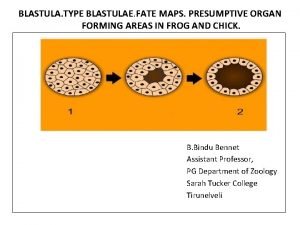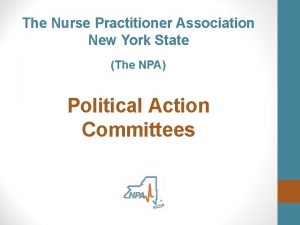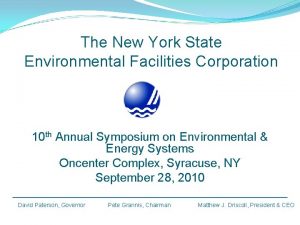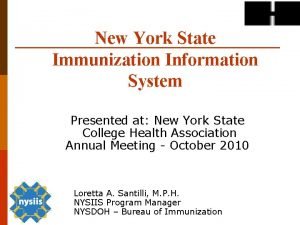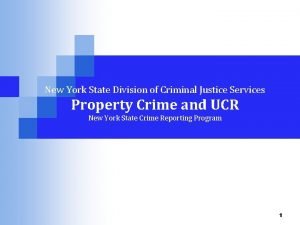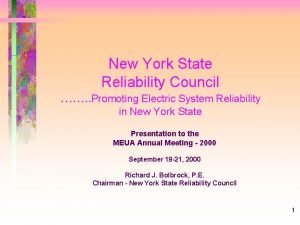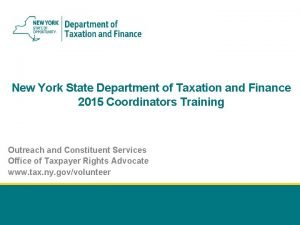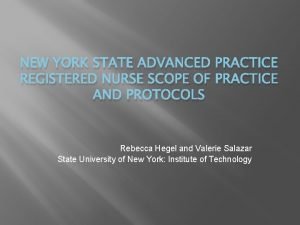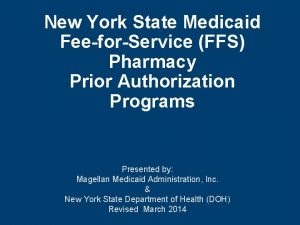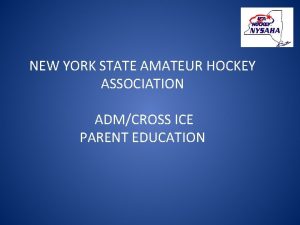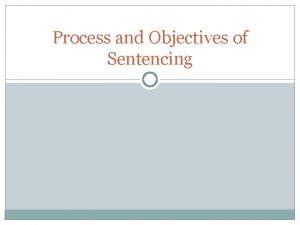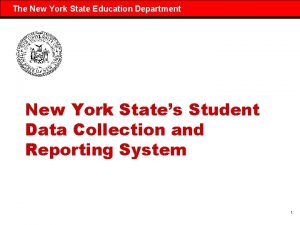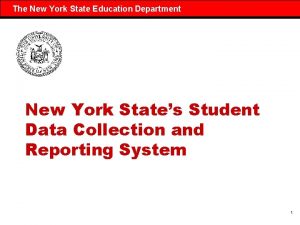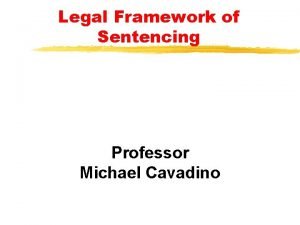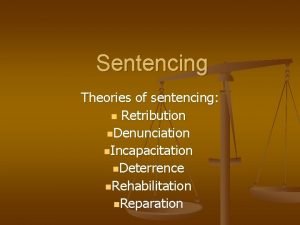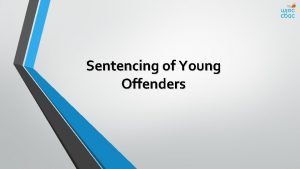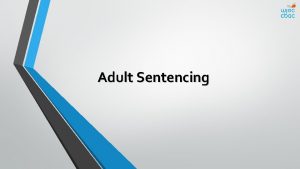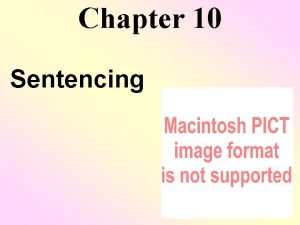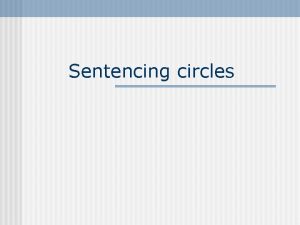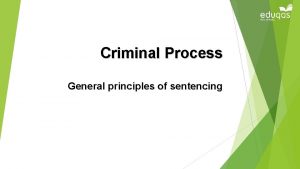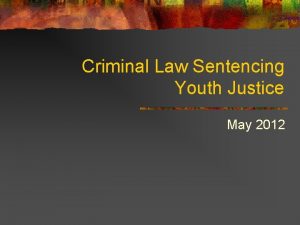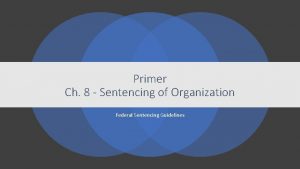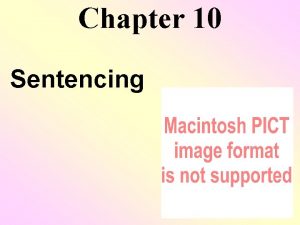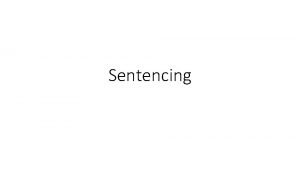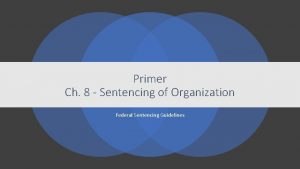SENTENCING IN NEW YORK STATE PRESUMPTIVE SENTENCING Specifies
























- Slides: 24

SENTENCING IN NEW YORK STATE

PRESUMPTIVE SENTENCING: Specifies an appropriate or "normal" sentence for each offense to be used as a baseline for a judge when meting out a punishment. The sentence is considered along with other relevant factors (aggravating or mitigating circumstances) in determining the actual sentence.

Aggravating Circumstances: make the crime more serious than the average instance of the given type of offense Examples- the offense was: -especially heinous and cruel. -committed with a deadly weapon. -committed for hire. -committed against a law enforcement officer

Aggravating Circumstances: make the crime more serious than the average instance of the given type of offense Mitigating Circumstances: may reduce the blameworthiness of the defendant. Pre-sentence Hearing: the examination of a convicted offender’s background prior to sentencing. Recidivism: the tendency of a convicted criminal to re-offend.

Mitigating Circumstances: may reduce the blameworthiness of the defendant. Examples- the defendant: -has no record of criminal conviction -has made substantial or full restitution -acted under strong provocation Pre-sentence Hearing: the examination of a convicted offender’s background prior to sentencing. Recidivism: the tendency of a convicted criminal to re-offend.

Types of Sentencing A) Determinate Sentencing - is the process of a court assigning a set prison term to a convicted offender. B) Indeterminate Sentencing - allows judge to take other factors into account when punishing Ex. Criminal history, attitude, circumstances Criticism- can lead to sentencing disparities Ex. Women get shorter terms Blacks get longer sentences

PAROLE - conditionally released from prison before the expiration of prisoner’s sentence. A)Supervised by parole officer B)Must follow conditions of parole.

C) Mandatory Minimums- determines a specific minimum sentence fornotes a specific crime. D) “ 3 Strikes and You’re Out” Policy- offenders convicted of third felony gets life sentence. E) Truth-in-Sentencing- criminals must serve 85% of sentence before release. **U. S. is a blend of all types depending on state and locality.


Percentages of Sentences (NY State) 28% = Local jail 32% = PROBATION 40% = State Prison

ADVANTAGES OF PROBATION A) Lower Cost B) Increased Employment C) Restitution (payback) D) Community Support E) Reduced Risk of criminal socialization DISADVANTAGES OF PROBATION A) Relative lack of punishment B) Increased risk to the community C) Increased Social Costs

SENTENCING GOALS A) Deterrence- assumes people will refrain from crimes fearing the harsh punishment Ø Criticism- 68% of convicts re-offend (recidivism) B) Incapacitation- removing the opportunity to reoffend w/ prison. Ø Criticism- criminals perfect criminal behavior in jail.

C) Retribution- An “eye for an eye” notes D) Rehabilitation- assumes criminal behavior can be improved w/o punishment Ex. Rehab, mental counseling, education E) Reformation- similar to rehabilitation but adds shame or stigma too. Ex. Scarlet Letter “A”

Capital Punishment (a. k. a Death Penalty) A)Pro-Death Penalty Arguments: • Eye for Eye Tooth for a Tooth. • Ensures they will never commit another crime • Deterrent of crime- (make criminals think twice) B)Anti-Death Penalty Arguments: • Not a deterrent of crime (criminals don’t care) • High cost • Wrong to take anyone’s life • “Life in prison” is worse

Death Penalty in America A. Introduced by English colonists B. George Kendall- first to be executed 1608 (spying; Jamestown, VA) C. On Crimes and Punishment essay (Cesare Beccaria 1767)- argues there’s no justification for taking one’s life. D. Thomas Jefferson- introduced bill in VA to use death penalty only for murder and treason. E. Dr. Benjamin Rush- argues death penalty is not a deterrent!

notes F) Pennsylvania 1834 - ends public executions to make d. p. more acceptable. G) States begin ending mandatory d. p. for crimes.



Death Penalty-Eligible Crimes A)Murder B)Treason (betraying one’s country) C)Kidnapping- if victim dies in offender’s custody

Methods Used A) Lethal injection- used most B) Electrocution C) Gas chamber D) Hanging E) Firing squad

Clemency- power of public official to prevent a death sentence by lowering punishment. Power to Grant Clemency A) Governor B) President (Federal crimes only)

Executions Declining (1999 -present)-Why? A) DNA Testing = exonerations (people being cleared of the crime) B) States abolishing it

Death Penalty Cases I. Furman vs. Georgia 1972 - suspends death penalty in the U. S. ; given too erratically. II. Gregg vs. Georgia 1976 A) reinstated death penalty only for murder B) 2 -Phase Trials: innocent or guilty & penalty phase

III. Atkins vs. Virginia 2002 - cannot execute the mentally disabled; (cruel/unusual punishment) IV. Roper vs. Simmons 2005 - cannot execute a minor (under 18); (cruel & unusual punishment)
 Hemastix color
Hemastix color Presumptive areas of blastula
Presumptive areas of blastula Positive identification example
Positive identification example Presumptive medicaid ohio
Presumptive medicaid ohio New york nurse practitioner association
New york nurse practitioner association New york state tap application
New york state tap application New york state teacher certification examinations
New york state teacher certification examinations New york state standards science
New york state standards science 2018 nys math test
2018 nys math test New york state mesonet
New york state mesonet State vegetable of new york
State vegetable of new york New york state environmental facilities corporation
New york state environmental facilities corporation New york state professional firefighters association
New york state professional firefighters association New york state immunization registry
New york state immunization registry New york state association of transportation engineers
New york state association of transportation engineers New york state industries
New york state industries Department of criminal justice services ny
Department of criminal justice services ny Nysrc
Nysrc Nysdot hdm
Nysdot hdm Nytprin exclusion code
Nytprin exclusion code Rn scope of practice ny
Rn scope of practice ny New york state fish
New york state fish New york state nickname
New york state nickname Emedny formulary
Emedny formulary New york state amateur hockey association
New york state amateur hockey association

